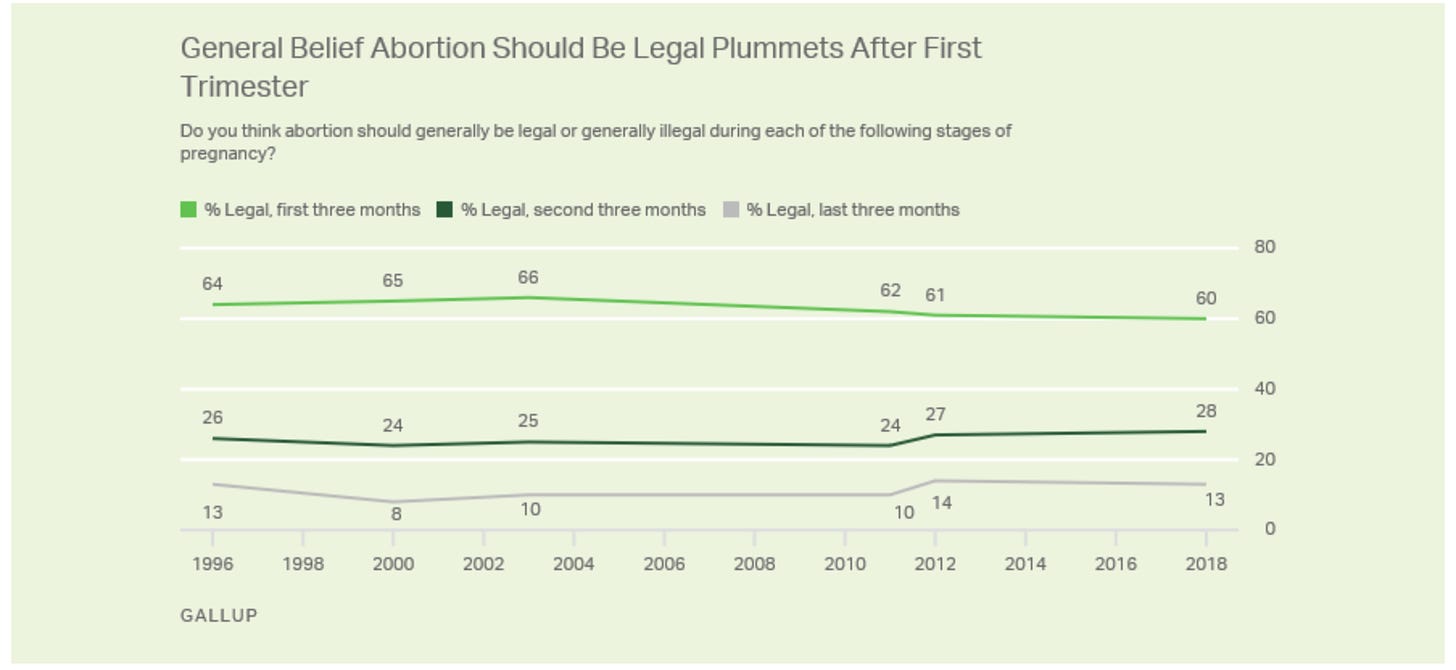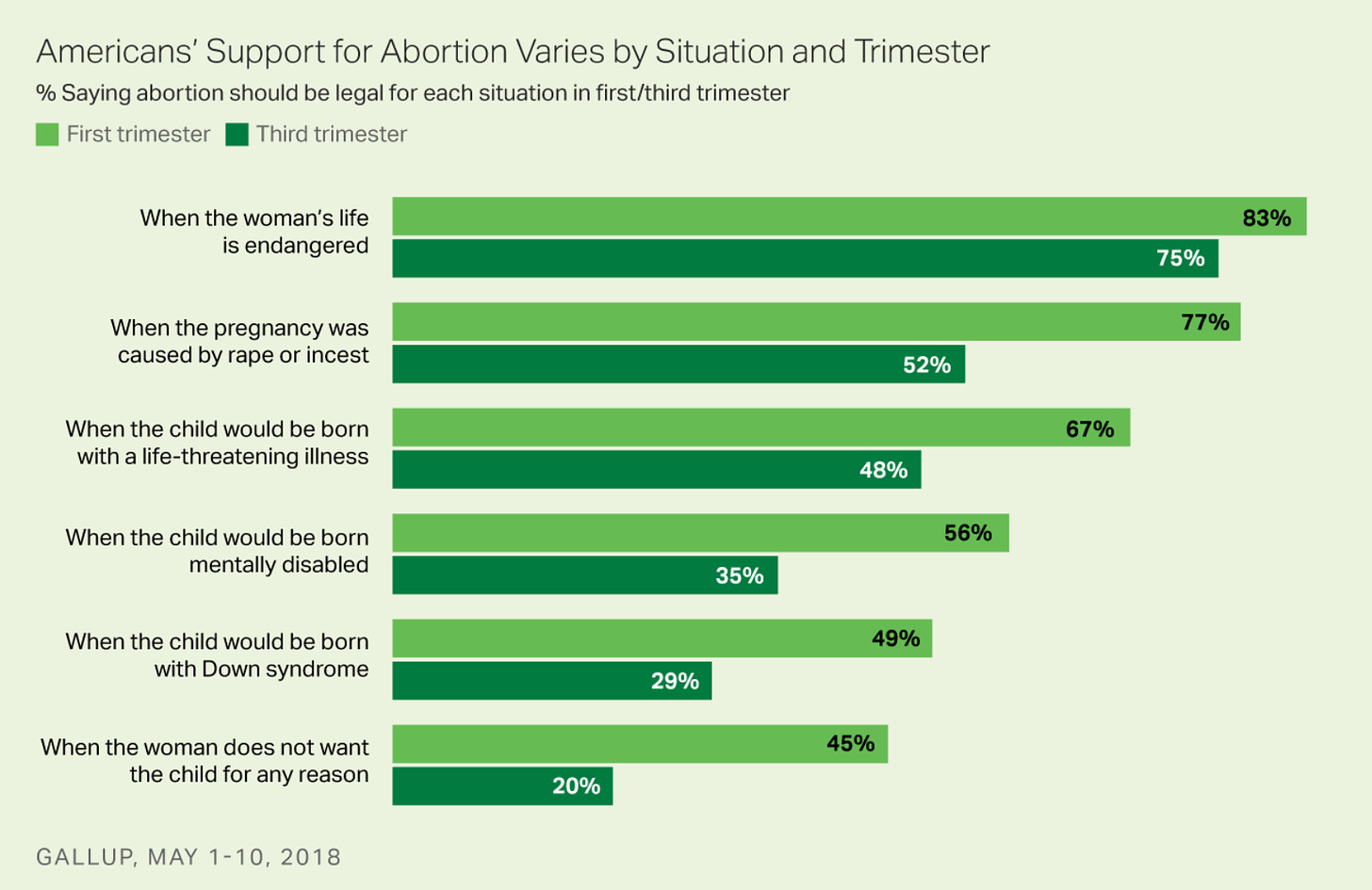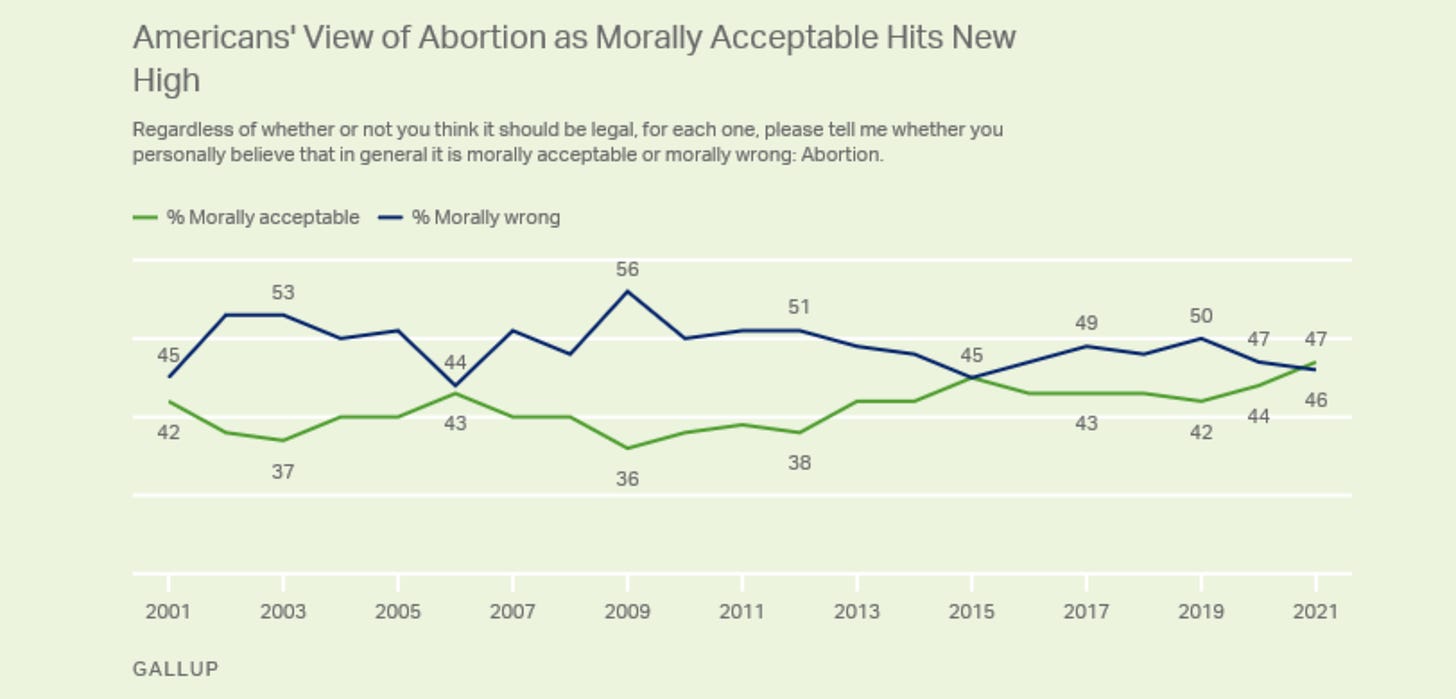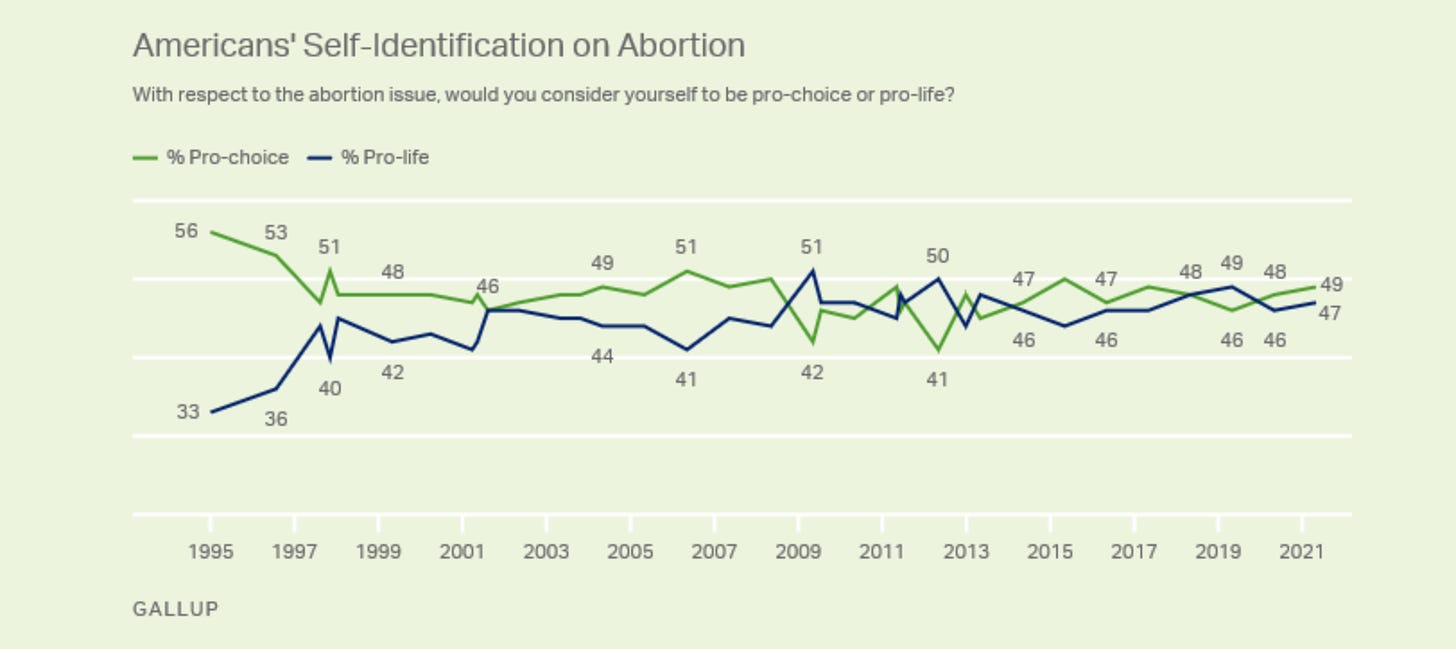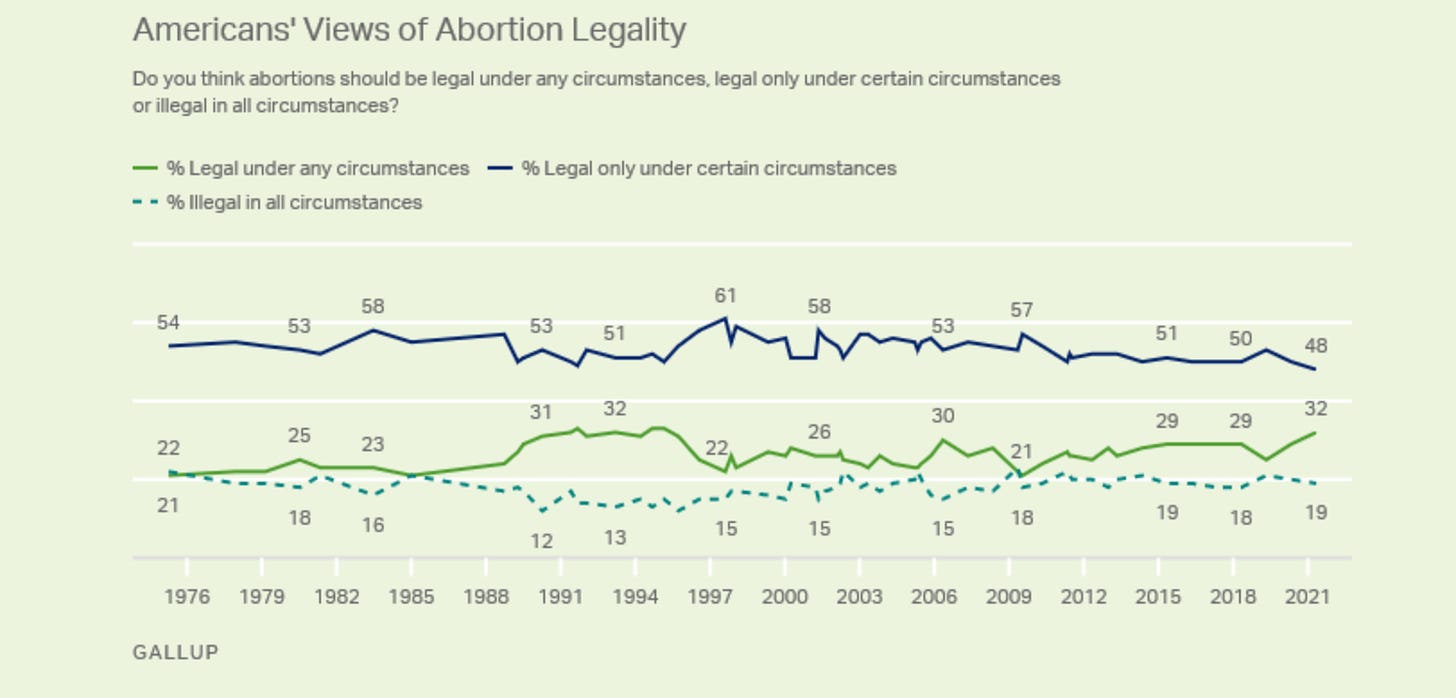Living in the Gray Area
By now I’m sure you’ve heard that the Supreme Court’s initial vote in the Dobbs case is to overturn abortion entirely. The draft opinion can’t really be described as anything other than an annihilation of the federal right to an abortion. Perhaps that makes you celebrate, perhaps that makes you terrified—but I hope it makes you think.
You’ll no doubt be bombarded by opinions from those celebrating and those terrified, but I don’t think you subscribe to this letter for opinions. If you do, I hope you've been thoroughly disappointed. Rather, what I hope you subscribe for are thoughtful pieces, limited to areas where I am considered an expert, that explore the gray areas of issues.
One of the few opinions I am consistently willing to give is that the death of nuance is the most dangerous trend for modern democracies and modern capitalist markets. There are very few, if any, matters of policy or economics that are black and white. Almost everything is some shade of gray. What I try to do in these letters is open up discussion about what shade of gray something is. People who argue things must only be black and white will never make any progress. The insistence that they are black or white has led to the United States stagnating as a market and as a democracy.
I am the first to admit the areas where I am not an expert. Just a few of those areas are reproductive medicine, constitutional rights to privacy and other unenumerated rights, bioethics, and spiritual manifestations. Abortion covers all of these. I am not smart enough to say at what point a fetus becomes a human. I am not in tune with God enough to say at what point a spirit enters a fetus, making it a child of God. I am not a constitutional scholar, so I can’t say what the correct interpretation of the right to privacy is. It is not included in the Constitution, though many legal cases have confirmed it through the Fourth Amendment. I cannot say whether, if we do have a right to privacy, that right includes abortion. All of these are questions that require specific experts—I am not one of them (although, I would be skeptical of any human who tells me they are in tune enough with God to know exactly what God wants).
So, what I thought might be helpful to see the gray areas is to give you an expert of my book. The book was a result of research exploring why so many young Americans are leaving Christianity and becoming actively hostile to it. Abortion is one of the reasons.
I hope you’re enjoying this letter so far. You can subscribe to make sure to catch every edition of The Constituent. It’s completely free!
As abortion is tracked more closely, the growing amount of data produced seems to suggest that criminalizing or prohibiting abortion does not affect the total number of abortions performed.1 Instead, women regularly risk their lives, and major medical complications, to end unwanted pregnancy.2 Banning abortion often only decreases the availability of non-abortion family planning service. This gives women who are determined not to have a child no other option than to obtain a dangerous and sometimes illegal abortion. Moreover, the data suggests anti-abortion policies often lead to more, rather than fewer, abortions.3 For example, Pakistan, which has strict prohibition against voluntary abortion,4 has one of the highest abortion rates in the world.5 However, the United States, where abortions are legal, now has its lowest abortion rate in recorded history.6
If, as a result of forbidding the procedure, tens of thousands of mothers die from unsafe abortions each year, and abortion rates are similar with or without safe access to abortion, then prohibitions on abortion may actually cause more deaths than abortion alone.7 This creates a dilemma within social ethics: if moral value is placed on the sanctity of life, allowing abortion may result in a higher moral society because the total loss of life is smaller. Unfortunately, corporate Christians in the United States seemed to be the group most willing to sacrifice the elderly and vulnerable to “save” the economy during the Coronavirus pandemic; so life may not actually hold the amount of value in their morals that they have projected it to hold.
However, if, as may be the case for many Christians, there is something inherently preferable about living in a society where the government makes a moral statement by not allowing abortion, then banning it is logical. This, too, highlights ideological inconsistencies.
President Trump’s favorite preacher, and trusted advisor, Paula White, asked God himself to abort all “satanic pregnancies”. She prayed, “In the name of Jesus, we command all satanic pregnancies to miscarry right now. We declare that anything that has been conceived in satanic wombs will miscarry, it will not be able to carry forth any plan of destruction, any plan of harm.”8
On the other hand, if actually preventing abortions, rather than making a moral statement, were really the goal of Christians, the most efficient way to reduce abortion would be to provide safe and unrestricted access to contraception.9
Of course, there is a third alternative. That is, people who don’t want kids could simply stop having sex. But, in a world where the President of the United States and leader of the Christian world has had multiple affairs and clergymen from many faiths rape and abuse parishioners, this suggestion is laughably naive.
Corporate Christians would rather go on with their crusade that makes themselves feel righteous, even if it results in more deaths or abortions. They would rather pay Norma McCorvey—who was Jane Roe in Roe v Wade—hundreds of thousands of dollars to lie and say she regretted her abortion.10 They would rather require emergency room admitting privileges for a procedure that has less risk than a colonoscopy.11
Note that none of these arguments have addressed or attempted to address when life begins, and whether abortion is murder. It is logical and consistent for someone to believe abortion is murder and be opposed to abortion as a practice, but also realize that prohibiting it may actually increase both the number of abortions and total deaths.
To the non-religious and the skeptics who observe Christianity from the outside, why would the church not push to advance access to contraception, and keep intact the heart of the Gospel, rather than surrender it to radical conservatives and nationalists just to push a policy that may not prevent the practice in question? Instead, Christians have sacrificed the heart of their gospel on the altar of LGBTQ+ rights and abortion.
Having fun? Learning something new? If so, do me a favor and let your friends know about The Constituent.
I want to emphasize again the nuance in abortion that often gets overlooked.
It can be true that at some point in a pregnancy abortion becomes murder, and still be true that banning abortion may cause an increase in both abortions and deaths. It is difficult—bordering on impossible—to say at what point abortion becomes murder. If any ended pregnancy is murder, than God allows as many as a quarter of all pregnanices to end in murder. Surely this isn’t the mother’s fault, so is it God committing the murder? If the answer is “no”, then it follows logically that all abortions cannot be murders.
Anyway, I hope you get the point. Nothing, abortion included, is black and white. As you get bombarded with opinions I hope you keep in mind the nuance. One side does not have to be right and the other wrong. They can both be right and both be wrong at the same time. Look for the gray, and think.
Just by way of information, I’ll leave you with a few graphs from Pew, who have really amazing data tracking what the public thinks about abortion.
Thanks for reading The Constituent. If you’d like to support the newsletter, here are a few options.
-Thanks,
Guttmacher Institute. “Induced Abortion Worldwide: GLOBAL INCIDENCE AND TRENDS,” March 2018. https://www.guttmacher.org/fact-sheet/induced-abortion-worldwide.
Stuart, Tessa. “This Is What It Was Like to Have an Illegal Abortion Before Roe v. Wade.” Rolling Stone Magazine, July 10, 2018. https://www.rollingstone.com/politics/politics-features/abortion-before-roe-v-wade-697382/.
Crane, Barbara B., and Jennifer Dusenberry. "Power and politics in international funding for reproductive health: the US Global Gag Rule." Reproductive health matters 12, no. 24 (2004): 128-137.
Hadid, Diaa, and Abdul Sattar. “Why The Abortion Rate In Pakistan Is One Of The World’s Highest.” NPR, November 28, 2018. https://www.npr.org/sections/goatsandsoda/2018/11/28/661763318/why-the-abortion-rate-in-pakistan-is-one-of-the-worlds-highest.
Population Council. “Induced Abortions and Unintended Pregnancies in Pakistan, 2012”. September, 2014. https://www.popcouncil.org/uploads/pdfs/2014RH_PostabortionCare_Pakistan.pdf.
McCammon, Sarah. “U.S. Abortion Rate Falls To Lowest Level Since Roe v. Wade.” NPR, January 17, 2017. https://www.npr.org/sections/thetwo-way/2017/01/17/509734620/u-s-abortion-rate-falls-to-lowest-level-since-roe-v-wade.
Hawkins, Summer Sherburne, Marco Ghiani, Sam Harper, Christopher F. Baum, and Jay S. Kaufman. "Impact of State-Level Changes on Maternal Mortality: A Population-Based, Quasi-Experimental Study." American Journal of Preventive Medicine 58, no. 2 (2020): 165-174.
Perrett, Connor. “Paula White, a White House Employee and Trump’s Spiritual Adviser, Calls for ‘Satanic Pregnancies to Miscarry Right Now.’” Business Insider, January 26, 2020. https://www.businessinsider.com/paula-white-calls-for-satanic-pregnancies-to-miscarry-right-now-2020-1.
Grimes, David A., Janie Benson, Susheela Singh, Mariana Romero, Bela Ganatra, Friday E. Okonofua, and Iqbal H. Shah. "Unsafe abortion: the preventable pandemic." The lancet 368, no. 9550 (2006): 1908-1919.
Mahdawi, Arwa. “Jane Roe’s Deathbed Confession Exposes the Immorality of the Christian Right.” The Guardian; US Edition, May 20, 2020. https://www.theguardian.com/commentisfree/2020/may/20/jane-roe-abortion-arwa-mahdawi.
Upadhyay, Ushma D., Sheila Desai, Vera Zlidar, Tracy A. Weitz, Daniel Grossman, Patricia Anderson, and Diana Taylor. "Incidence of emergency department visits and complications after abortion." Obstetrics & Gynecology 125, no. 1 (2015): 175-183.





